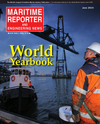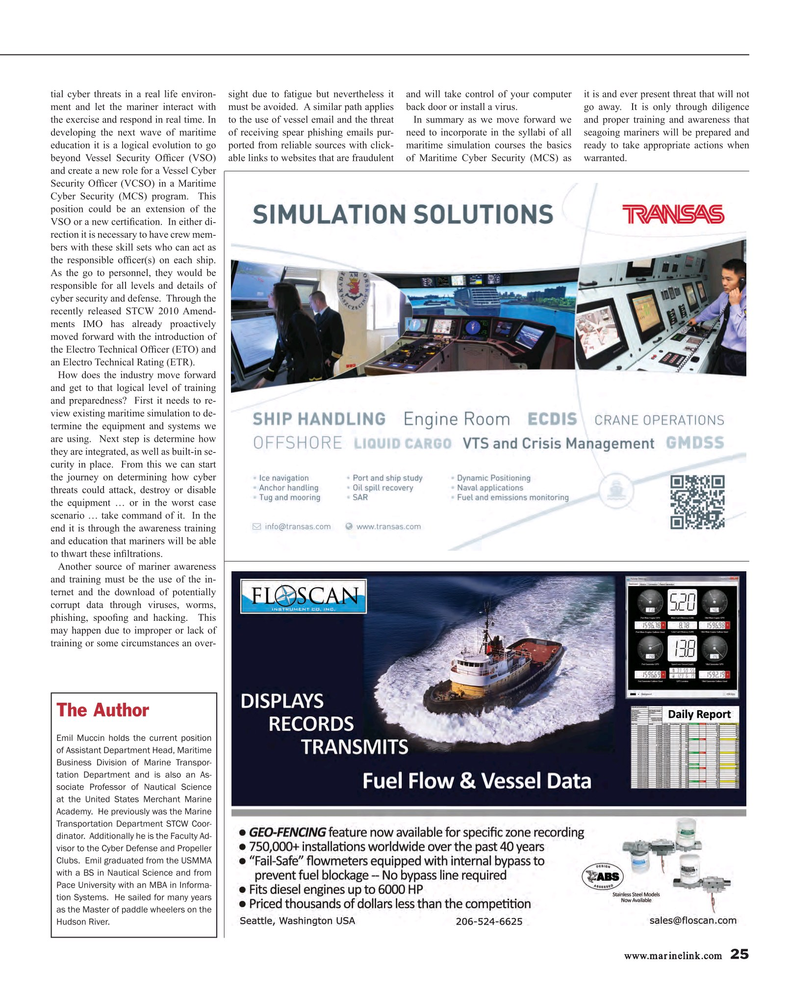
Page 25: of Maritime Reporter Magazine (June 2015)
Annual World Yearbook
Read this page in Pdf, Flash or Html5 edition of June 2015 Maritime Reporter Magazine
tial cyber threats in a real life environ- sight due to fatigue but nevertheless it and will take control of your computer it is and ever present threat that will not ment and let the mariner interact with must be avoided. A similar path applies back door or install a virus. go away. It is only through diligence the exercise and respond in real time. In to the use of vessel email and the threat In summary as we move forward we and proper training and awareness that developing the next wave of maritime of receiving spear phishing emails pur- need to incorporate in the syllabi of all seagoing mariners will be prepared and education it is a logical evolution to go ported from reliable sources with click- maritime simulation courses the basics ready to take appropriate actions when beyond Vessel Security Of? cer (VSO) able links to websites that are fraudulent of Maritime Cyber Security (MCS) as warranted. and create a new role for a Vessel Cyber
Security Of? cer (VCSO) in a Maritime
Cyber Security (MCS) program. This position could be an extension of the
VSO or a new certi? cation. In either di- rection it is necessary to have crew mem- bers with these skill sets who can act as the responsible of? cer(s) on each ship.
As the go to personnel, they would be responsible for all levels and details of cyber security and defense. Through the recently released STCW 2010 Amend- ments IMO has already proactively moved forward with the introduction of the Electro Technical Of? cer (ETO) and an Electro Technical Rating (ETR).
How does the industry move forward and get to that logical level of training and preparedness? First it needs to re- view existing maritime simulation to de- termine the equipment and systems we are using. Next step is determine how they are integrated, as well as built-in se- curity in place. From this we can start the journey on determining how cyber threats could attack, destroy or disable the equipment … or in the worst case scenario … take command of it. In the end it is through the awareness training and education that mariners will be able to thwart these in? ltrations.
Another source of mariner awareness and training must be the use of the in- ternet and the download of potentially corrupt data through viruses, worms, phishing, spoo? ng and hacking. This may happen due to improper or lack of training or some circumstances an over-
The Author
Emil Muccin holds the current position of Assistant Department Head, Maritime
Business Division of Marine Transpor- tation Department and is also an As- sociate Professor of Nautical Science at the United States Merchant Marine
Academy. He previously was the Marine
Transportation Department STCW Coor- dinator. Additionally he is the Faculty Ad- visor to the Cyber Defense and Propeller
Clubs. Emil graduated from the USMMA with a BS in Nautical Science and from
Pace University with an MBA in Informa- tion Systems. He sailed for many years as the Master of paddle wheelers on the
Hudson River. www.marinelink.com 25
MR #6 (18-25).indd 25 MR #6 (18-25).indd 25 6/9/2015 10:52:03 AM6/9/2015 10:52:03 AM

 24
24

 26
26
